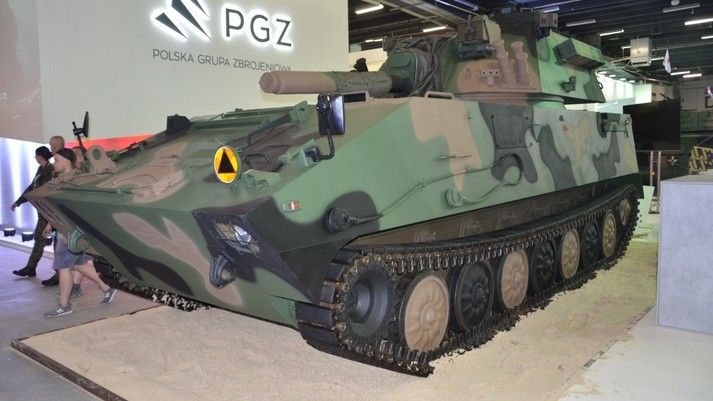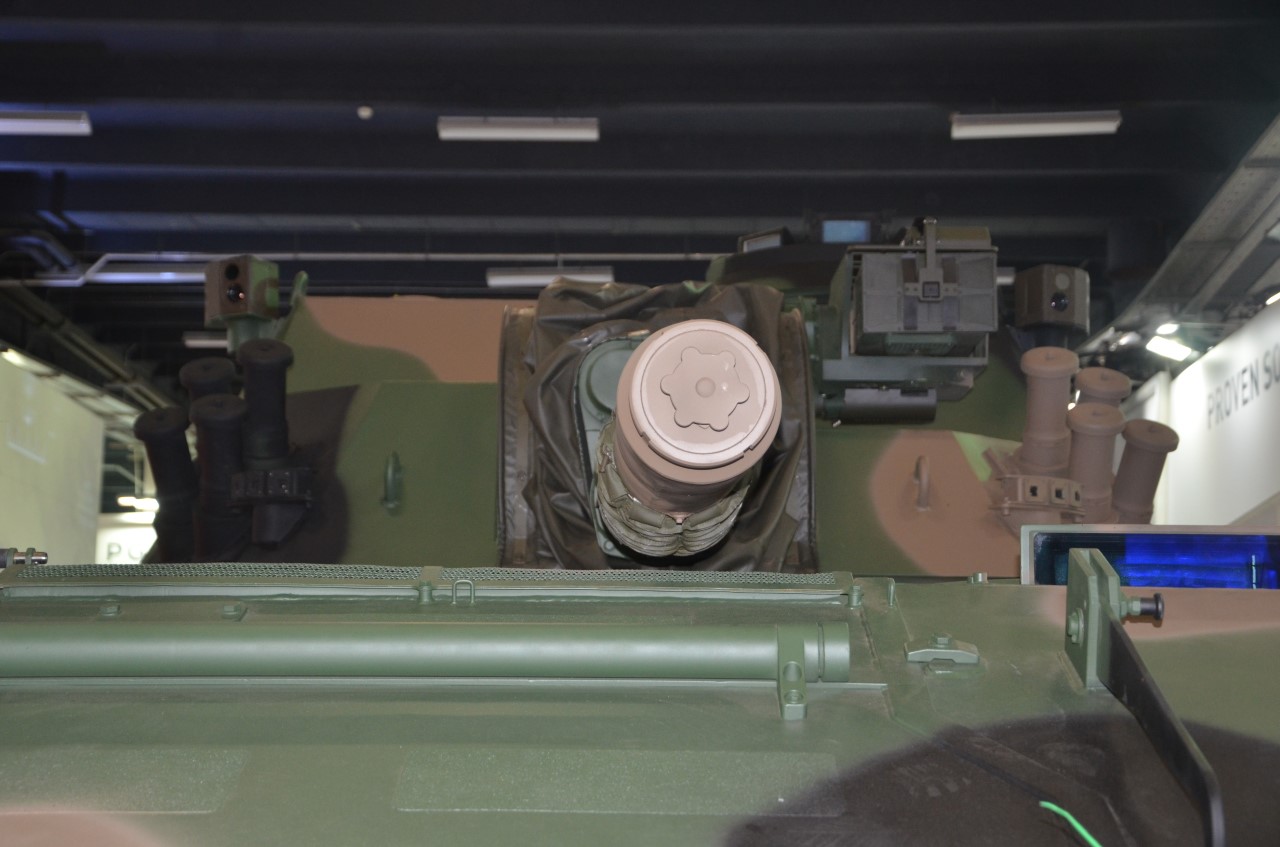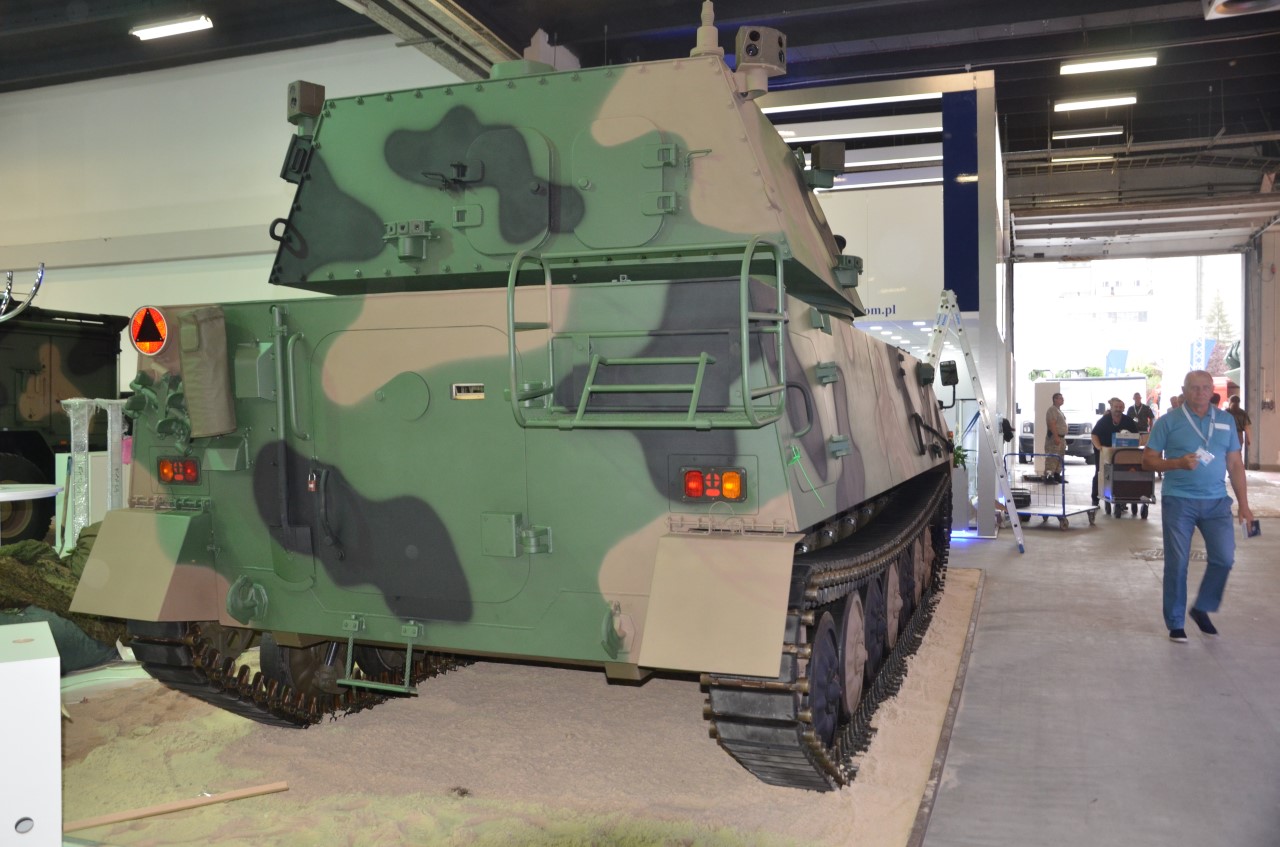Strona główna
MSPO 2019: Rak Based on a new Platform

MSPO 2019 defence industry exhibition organized in Kielce has been used by HSW S.A. as an opportunity to roll out another variant of the Rak self-propelled mortar, under the M120G designation. The “G” suffix refers to a tracked (gąsienicowa in Polish) platform on which the mortar is placed. 4.0 is the unofficial designation of the variant - which means that it is the fourth version of the tracked mortar platform.
Placing the 120 mm automatic mortar on the adapted 122 mm 2S1 Gvozdika tracked platform initiated the Polish self-propelled mortar development programme. Gvozdika system was being series manufactured as HSW until August 1993. Scenario as such was forced externally, by the circumstances emerging at the time. Following the presentation of the Patria AMOS system at the Artillery and Armament Training Centre in the city of Thorn (Toruń) range, HSW stood up to the challenge, declaring that it would rapidly develop its own design of similar or better characteristics, making it possible to equip the Polish military with a Polish-made solution. The work was undertaken immediately with the first results becoming tangible after a year. The first public presentation of the autonomous turret system of the 120 mm automatic mortar took place in 2008, during the MSPO event. The turret was presented on a stationary stand, not on a vehicular platform.
It was impossible to continue the R&D effort, firing tests included, of the turret alone, with sole involvement of a stationary test station at an artillery range. At the beginning it was impossible, for a number of reasons, to access the wheeled platform in a form of Rosomak APC. The procurement procedures related to the Rosomak APC were being delayed. Thus, for the purpose of the initial phase of the test programme the mortar was installed on a specially adapted Gvozdika platform. Starting from 2009, HSW S.A. was working on the Rak system placed on this temporary chassis.
Ultimately, thanks to the decisive stance adopted by the military, HSW has managed to transfer the Rak mortar onto the target wheeled platform. The result is fairly well known: contractual agreement signed in April 2016, concerning 64 Rak mortars and the recent declaration that Mariusz Błaszczak, head of the MoD has made at HSW S.A., when signing the agreement concerning the AWA vehicle deliveries. The Polish Ministry of Defence is soon going to order further Rak systems. Head of the MoD suggested that a relevant agreement could be potentially signed within the current quarter.
In the meantime HSW also began work on placing the M120 system on a tracked carrier that would be better than the Gvozdika solution. This was done in parallel with refinement of the wheeled platform design solutions. This move was done in advance, before any interest was expressed with regards to delivery of this variety as means of support for heavy, tracked brigades. It was expected that interest as such would be expressed once the demand for wheeled Rak mortars is met. It was assumed that it would be optimal to use the LPG platform developed back in 2009, for the purpose of creating the command vehicles for the Regina modules. This marked the birth of another tracked variant, also known, unofficially, as “Rak 3.0”.
Following the above, another option came to the surface. The German partner carrying out active acquisition in one of the countries in Asia suggested that an opportunity may emerge to secure an order concerning a 120 mm self-propelled mortar platform. Rak system was meeting the requirements. The German bidder convinced the potential buyer that a mortar system as such could utilize the German Marder IFV as a base platform. A lot of Marders were placed in the Bundeswehr’s surplus stock, as the IFV in question was expected and planned to be replaced with a new generation IFV. The above refers to the Puma IFV. Marder platform was then delivered to the HSW S.A. facility. In a few weeks adaptation was completed and Marder could accommodate the Rak turret system. The vehicle, in this form, was presented during the 2013 edition of the MSPO event.
Unfortunately, the contract was not concluded, for reasons remaining beyond influence of the Polish manufacturer. The Germans have changed the concept of use of the obsolete Marder IFV. After a little over a year from the premiere, Rak 4.0 was disassembled and the chassis was returned to Germany.
Read more: Eurosatory 2016: Rak Mortar from Stalowa Wola
Another Rak tracked variant has been presented during the MSPO 2019 event. It may be unofficially referred to as “Rak 4.0”. This M120G Rak mortar is based on the Opal tracked chassis that has also been developed by HSW. The well known and proven Opal vehicle has already been upgraded (JaMZ engine was replaced with an MTU power-pack). However, in case of Rak it underwent further modifications.
The classic suspension system was replaced with a hydropneumatic solution. HSW S.A. has not really disclosed the source of the design idea for the hydropneumatic system - whether they come from the Krab sph, Borsuk IFV or whether they are another path being based on an original design remains unknown.
However, considering the above, Rak in this configuration could be treated as an important technology demonstrator for this kind of armament. The design transfers the M120 Rak system into the area of much more modern systems, design-wise. This also eliminates the need to launch manufacturing process from a scratch, with regards to some of the components that have not been manufactured for years and that belong to conventional suspension system based on torsion bars.
“Rak based on Opal” may be perceived as a technology demonstrator, but it could also become a full-fledged production proposal. Opal platform has passed the qualification tests already, thus the suspension may be replaced with a hydropneumatic solution only with involvement of type certification. Procedure as such takes less time, it is less complex and cheaper than a full test programme applicable to an entirely new product. In that manner, a much more modern variant of the M120G platform may be obtained in a relatively short time, at a relatively low price.
HSW did not reveal everything. However, one may expect that this is not the concluding sentence of the tracked Rak narrative. It may be expected that next year, another variant of the mortar would be presented, on the latest base platform. Borsuk IFV. In 2020 the new IFV prototype should go through the qualification test programme. However, nothing stands in the way for the HSW engineers to create a variant of the Borsuk vehicle that could accommodate the Rak mortar turret module.
The platform as such does not have to be amphibious (M120K mortar on wheeled chassis also lost its amphibious capabilities). It could potentially be fitted with a simpler and cheaper power-pack that would be sufficient for an 18-19 tonnes support vehicle that does not need to face so stringent mobility requirements as the ones defined for the current IFV configuration. Rapid development of a design as such may be accelerated by the experience gathered when working on the Regina module WD/WDSz platforms weighing 17 tonnes and using the MTU 6V199TE20 engines with a power output of 260 kW, coupled with the LSG 1000 automatic gearbox.
What solutions would be used in the end? We will find out next year, most probably. The Opal-based Rak presented during the MSPO 2019 event seems to be a signal that HSW is willing to shorten the break between manufacturing the wheeled and tracked variant to the shortest time possible. The 18th Mechanized Brigade that is to be formed in the future would be probably the first unit to use this system. The element is to reach combat readiness in 2026.
The Rak tracked variant has been, in fact, in existence since 2015. In parallel, further development is also being done with regards to the Rak mortar turret.
Our work is focused on increasing the rate of fire that Rak is offering. Increasing of the maximum range is not among our current priorities. Elements and components decisive for internal ballistics of the mortar have been developed with assumed internal pressures of around 250 MPa. There is still a lot of reserve there, that is not being fully utilized by the ammunition. And our influence does not extend to development of the new mortar rounds.
The manufacturer declares that the Rak system offers rate of fire at the level of 8 rounds per minute. There is still some performance reserve available within the design of the autoloader and loading mechanisms, to make this figure even better. However, one should remember that type of the platform on which the turret is placed also influences this parameter.

In case of a conventional suspension tracked chassis (torsion bar suspension) a phenomenon occurs, that sees the chassis rocking after the round leaves the mortar barrel. The rocking phenomenon is longer at lower elevations. And the Rak system, we should recall, has the direct fire capability. The lower the elevation is, the more the recoil forces are acting in parallel to the ground which creates a strong rocking force.
The phenomenon in question has also been troublesome in case of the Krab sph. In case of Krab, replacement of the Kalina platform (with torsion-bar suspension) with the K9 design (hydropneumatic suspension) spectacularly enhanced the neutralization of rocking, and thus the time required for the howitzer to be stabilized was made shorter which, consequently, shortens the interval between the shots.
Analogous phenomena have also been recorded in case of the mortar. However, the impact that shots have on the platform is much smaller, as the propelling charge is lighter and the round reaches lower muzzle velocities, also weighing less. However, the platform to which the recoil force is applied is also lighter. Krab howitzer that shoots 45 kilogram projectiles weighs more than 48 tonnes. Meanwhile, Rak, shooting a 16 kilogram round, weighs 18 tonnes. It also features a different recoil mechanism design.
Work on increasing the rate of fire of the M120 Rak mortar should not create any problems. Performance at the level exceeding 10 rounds per minute is perfectly within reach. It would mean that Rak would be firing each round in intervals shorter than 6 seconds. The interval would be lower than 7.5 - 10 seconds, achievable now. This would have a decisive impact on effectiveness of the mortar, especially during the MRSI engagements. Furthermore, the higher rate of fire may also increase the survival rate of the vehicle. The mission may be carried out more quickly and Rak mortars would be able to leave the firing position quicker, thus avoiding the counter-battery fire.
Other developmental efforts pertaining to the Rak mortar system are defined without any details, as those cannot be disclosed at this stage. It may however be said that those efforts are related to the option of increasing the level of autonomy for the mortar turret, so that the Rak platform could be operated in a completely unmanned setting on the battlefield. Reaching this goal is not a problem for the designers, as they reassuringly claim. Experience in that field has been now gathered since a couple of years.
HSW does not confirm the fact that the Ministry of Defence makes any suggestions that work shall be undertaken to allow the mortar to fire other types of ammunition, different from the types that are being developed by the Polish industry. Let us recall the fact that ZM Dezamet is the facility that works on development of the primary Rak mortar ammo. Meanwhile, PGMs that utilize laser guidance are being developed by Mesko, jointly with Telesystem-Mesko.

Rak self-propelled mortar is becoming much more mature, day by day. Most of 64 examples ordered within the framework of the first contract have already been delivered. Only one more module is expected to be delivered soon, using the wheeled platform. Declaration made by Minister Błaszczak in August may mean that the deliveries would, probably, continue, at least to some extent.
In a longer run, once the units using the Rosomak APC or the units that would be using the said platform in the future, receive their Rak mortars, the military may express its interest in a tracked-platform mortar. System as such could act as means of support for the elements expected to be equipped with the new Borsuk amphibious IFVs. Borsuk IFV is another product that is under development at HSW. Integration of the Rak system on a variety of tracked platforms proves the flexibility of the mortar that can be mounted on a myriad of different carriers. Thus, the “tracked Rak” may be easily tailored to the customer requirements, and the above concerns both Polish as well as foreign users.
Jerzy Reszczyński
